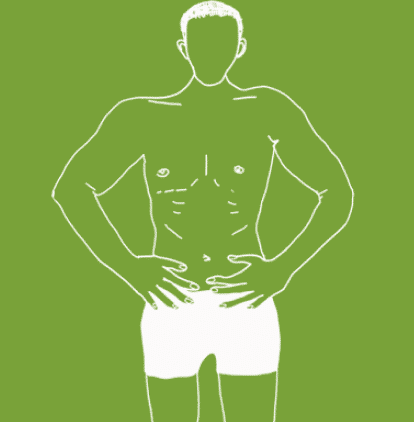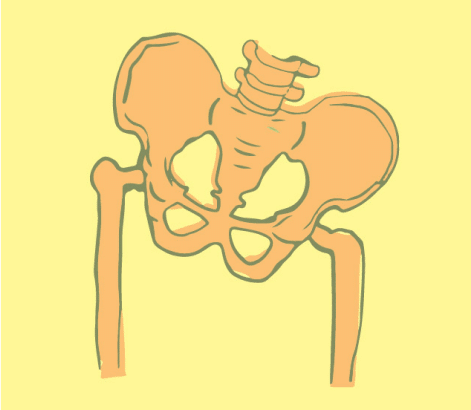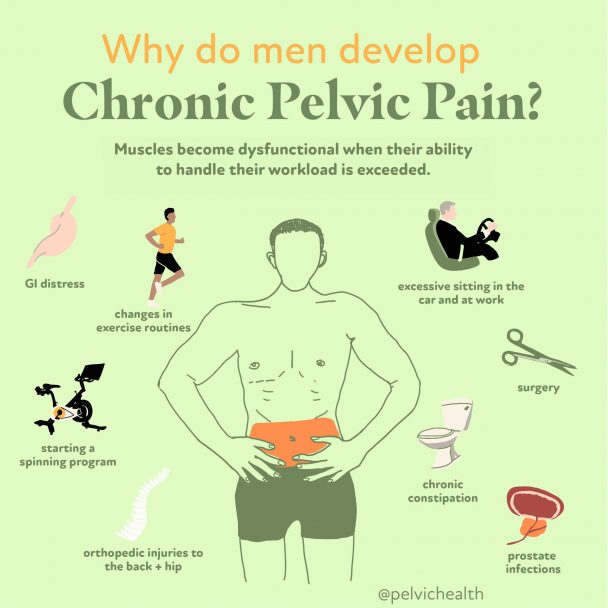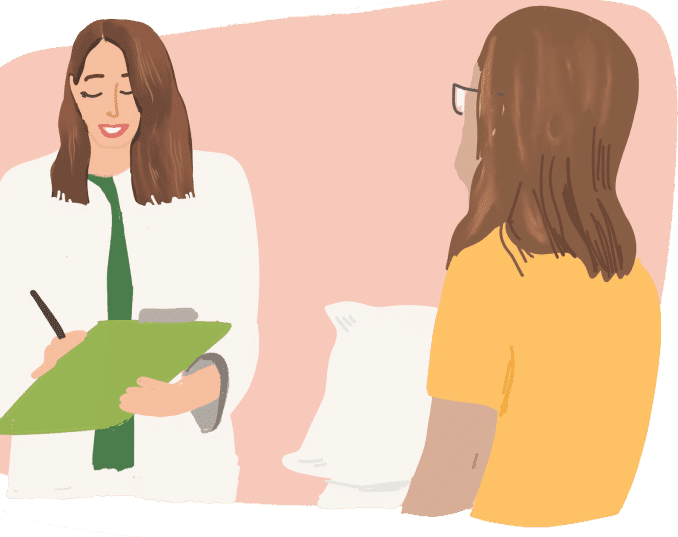

Common Symptoms in Men May Include:
- Discomfort described as burning, aching, or itching in the genital, anal, or perineal area
- Increased pain with prolonged sitting, vigorous activity, or tight clothing
- Urinary problems such as hesitancy, urgency, frequency, or a weak stream
- Pain during ejaculation, including tenderness in the scrotum or perineum
- Some men notice erectile difficulties and lower force during ejaculation
- GI issues like constipation, gas, and bloating
- Discomfort that appears spontaneously or gets worse after exercise or sexual activity
- Intermittent or continuous episodes of discomfort
If you’re in Poway and experiencing these symptoms, pelvic floor therapy might be the precise intervention that can help you feel normal again.
Common Symptoms in Men May Include:
- Discomfort described as burning, aching, or itching in the genital, anal, or perineal area
- Increased pain with prolonged sitting, vigorous activity, or tight clothing
- Urinary problems such as hesitancy, urgency, frequency, or a weak stream
- Pain during ejaculation, including tenderness in the scrotum or perineum
- Some men notice erectile difficulties and lower force during ejaculation
- GI issues like constipation, gas, and bloating
- Discomfort that appears spontaneously or gets worse after exercise or sexual activity
- Intermittent or continuous episodes of discomfort
If you’re in Poway and experiencing these symptoms, pelvic floor therapy might be the precise intervention that can help you feel normal again.

Associated Diagnoses
Chronic Pelvic Pain Syndrome/Male Pelvic Pain, Chronic Nonbacterial Prostatitis, Pudendal Neuralgia, Hard Flaccid Syndrome and Interstitial Cystitis/Painful Bladder Syndrome are all pain syndromes that cause pelvic pain due to pelvic floor dysfunction.

Associated Diagnoses
Chronic Pelvic Pain Syndrome/Male Pelvic Pain, Chronic Nonbacterial Prostatitis, Pudendal Neuralgia, Hard Flaccid Syndrome and Interstitial Cystitis/Painful Bladder Syndrome are all pain syndromes that cause pelvic pain due to pelvic floor dysfunction.

- Surgical trauma (vasectomy, benign prostatic hyperplasia (BPH) interventions, prostatectomy)
- Orthopedic injuries or other traumas (spine, hip, knee, and/or ankle injuries/pathology, accidents)
- Biomechanical or structural dysfunction (hip dysfunction, piriformis syndrome, scoliosis, leg length discrepancy)
- Excessive exercise or changes to exercise routine
- Excessive sitting
- Chronic constipation and straining
- Jelqing and/or attempts at gential enhancement or foreskin regeneration
- In rare cases, bladder, prostate, or sexually transmitted infections after successful resolution of infection
- The majority of men with pelvic pain, with or without urinary or bowel complaints, have pelvic floor dysfunction

Causes of Pelvic Pain
- Surgical trauma (vasectomy, benign prostatic hyperplasia (BPH) interventions, prostatectomy)
- Orthopedic injuries or other traumas (spine, hip, knee, and/or ankle injuries/pathology, accidents)
- Biomechanical or structural dysfunction (hip dysfunction, piriformis syndrome, scoliosis, leg length discrepancy)
- Excessive exercise or changes to exercise routine
- Excessive sitting
- Chronic constipation and straining
- Jelqing and/or attempts at gential enhancement or foreskin regeneration
- In rare cases, bladder, prostate, or sexually transmitted infections after successful resolution of infection
- The majority of men with pelvic pain, with or without urinary or bowel complaints, have pelvic floor dysfunction

Diagnostic Challenges
It’s frustrating but true—many men with pelvic pain aren’t correctly diagnosed for years, with research showing it can take up to seven years. The symptoms can closely mimic prostatitis, bladder infections, or STIs, which often leads providers to treat patients with antibiotics before confirming a diagnosis. This approach overlooks the fact that the actual cause may be pelvic floor dysfunction—a condition that many healthcare professionals don’t even realize affects men. Adding to the challenge is that much of the training in pelvic floor therapy has historically focused on female anatomy. PHRC is different—we’ve trained specifically to support men, and some days we actually see more male patients than female ones.
It is quite common for men suffering from pelvic pain to be mistakenly labeled as having “prostatitis,” which leads many to be unnecessarily treated with antibiotics. Yet, research consistently shows that more than 90% of men who complain of pelvic or genitourinary symptoms actually do not have a prostate infection. Rather, most fall into what the National Institutes of Health refers to as Category IIIa or IIIb, which are both subsets of Chronic Pelvic Pain Syndrome (CPPS).
Here is a breakdown of the NIH’s prostatitis classifications:
Category I: Acute bacterial prostatitis – features acute, often severe symptoms like fever, chills, and urinary tract infection caused by bacterial agents.
Category II: Chronic bacterial prostatitis – involves long-term bacterial presence in the prostate and may result in repeated bouts of urinary tract infections.
Category IIIa: Inflammatory CPPS – white blood cells are present in semen or prostatic secretions, indicating an inflammatory response.
Category IIIb: Non-inflammatory CPPS – symptoms are similar to those in IIIa, but there are no inflammatory markers found in bodily fluids.
Category IV: Asymptomatic inflammatory prostatitis – inflammation is found during diagnostic testing, though the individual has no outward symptoms or discomfort.
Diagnostic Challenges
It’s frustrating but true—many men with pelvic pain aren’t correctly diagnosed for years, with research showing it can take up to seven years. The symptoms can closely mimic prostatitis, bladder infections, or STIs, which often leads providers to treat patients with antibiotics before confirming a diagnosis. This approach overlooks the fact that the actual cause may be pelvic floor dysfunction—a condition that many healthcare professionals don’t even realize affects men. Adding to the challenge is that much of the training in pelvic floor therapy has historically focused on female anatomy. PHRC is different—we’ve trained specifically to support men, and some days we actually see more male patients than female ones.
It is quite common for men suffering from pelvic pain to be mistakenly labeled as having “prostatitis,” which leads many to be unnecessarily treated with antibiotics. Yet, research consistently shows that more than 90% of men who complain of pelvic or genitourinary symptoms actually do not have a prostate infection. Rather, most fall into what the National Institutes of Health refers to as Category IIIa or IIIb, which are both subsets of Chronic Pelvic Pain Syndrome (CPPS).
Here is a breakdown of the NIH’s prostatitis classifications:
Category I: Acute bacterial prostatitis – features acute, often severe symptoms like fever, chills, and urinary tract infection caused by bacterial agents.
Category II: Chronic bacterial prostatitis – involves long-term bacterial presence in the prostate and may result in repeated bouts of urinary tract infections.
Category IIIa: Inflammatory CPPS – white blood cells are present in semen or prostatic secretions, indicating an inflammatory response.
Category IIIb: Non-inflammatory CPPS – symptoms are similar to those in IIIa, but there are no inflammatory markers found in bodily fluids.
Category IV: Asymptomatic inflammatory prostatitis – inflammation is found during diagnostic testing, though the individual has no outward symptoms or discomfort.
Treatment:
How We Can Help You

If you’re in Poway and grappling with persistent pelvic pain, working with a physical and occupational therapists who specializes in the pelvic floor could make all the difference. Your initial visit will include a detailed review of your symptoms, health history, previous diagnoses, and any treatments you’ve attempted. We realize how discouraging it can be to seek help for this condition, especially when past efforts have failed to provide relief.
During the physical assessment, your therapist will examine your pelvic muscles, tissue sensitivity, joint function, nerve activity, and movement patterns. This thorough approach allows us to create an individualized assessment explaining the likely origin of your pain and setting goals for both short-term improvement and long-term recovery. Men in Poway typically attend sessions one to two times weekly for about 12 weeks and are provided with customized exercises to support healing at home. Your therapist may also communicate with your other providers to coordinate care. You’re not alone in this—Beyond Basics is here to help you recover fully.

Treatment:
How We Can Help You
If you’re in Poway and grappling with persistent pelvic pain, working with a physical and occupational therapists who specializes in the pelvic floor could make all the difference. Your initial visit will include a detailed review of your symptoms, health history, previous diagnoses, and any treatments you’ve attempted. We realize how discouraging it can be to seek help for this condition, especially when past efforts have failed to provide relief.
During the physical assessment, your therapist will examine your pelvic muscles, tissue sensitivity, joint function, nerve activity, and movement patterns. This thorough approach allows us to create an individualized assessment explaining the likely origin of your pain and setting goals for both short-term improvement and long-term recovery. Men in Poway typically attend sessions one to two times weekly for about 12 weeks and are provided with customized exercises to support healing at home. Your therapist may also communicate with your other providers to coordinate care. You’re not alone in this—Beyond Basics is here to help you recover fully.
How Can We Help You?
Got a question or something you’d like to share? Fill out the form below to contact us. An email address is required to ensure we can get back to you. All details you provide will be treated with the utmost confidentiality.

Join The Newsletter. Win a copy of our book, “Pelvic Pain Explained!”
We love getting to know our website visitors. Please tell us a little bit about yourself and get the latest info via PHRC e-newsletter!
*Subscribers automatically eligible to win our book, “Pelvic Pain Explained.”
This powerful resource, Pelvic Pain Explained, outlines the full scope of the pelvic pain experience—from the initial onset and misdiagnosis to the overwhelming task of exploring treatment paths. It captures the unseen toll such pain can take on one’s mental health and relationships, revealing the broader impact of a condition that is often misunderstood and overlooked.


